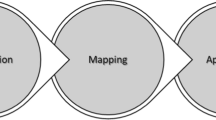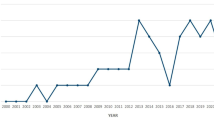Abstract
The Accreditation Board of Engineering and Technology (ABET) has declared that to achieve accredited status, “engineering programs must demonstrate that their graduates have an understanding of professional and ethical responsibility.” Many engineering professors struggle to integrate this required ethics instruction in technical classes and projects because of the lack of a formalized ethics-in-design approach. However, one methodology developed in human-computer interaction research, the Value-Sensitive Design approach, can serve as an engineering education tool which bridges the gap between design and ethics for many engineering disciplines. The three major components of Value-Sensitive Design, conceptual, technical, and empirical, exemplified through a case study which focuses on the development of a command and control supervisory interface for a military cruise missile.
Similar content being viewed by others
References
ABET. (2003) “Criteria for Accrediting Engineering Programs (2003–2004)”, Accreditation Board for Engineering and Technology, Baltimore.
Cummings, M.L. and Lo, J. (2004) Globalizing Engineering Ethics Education Through Web-Based Instruction, ISTAS 2004, Worcester, MA.
Friedman, B. (1999) “Value-sensitive design: A research agenda for information technology”, Contract No.: SBR-9729633, University of Washington.
Friedman, B. and Kahn, P.H. (1997) Human Agency and Responsible Computing: Implications for Computer System Design. Human Values and the Design of Computer Technology, B. Friedman Eds., CSLI Publications Stanford, CA, 221–235.
Friedman, B. and Kahn, P.H. (2003) Human values, ethics, and design. Handbook on Human-Computer Interaction, J. Jacko and A. Sears Eds., Lawrence Erlbaum Associates Mahwah, NJ, 1177–1201.
Friedman, B., Kahn, P.H., and Borning, A. (2002) “Value sensitive design: Theory and methods”. Technical Report 02-12-01, University of Washington, Computer Science and Engineering.
Friedman, B. and Nissenbaum, H. (1996) Bias in computer systems. ACM Transactions on Information Systems 14: 330–347.
Royce, W.W. (1970) Managing the development of large software systems: Concepts and techniques. WESCON Technical Papers: 14, A1-1-A1-9.
Boehm, B. (1988) A Spiral Model of Software Development and Enhancement. Computer: 61–72.
National Society of Professional Engineers. (2002) NSPE Code of Ethics.
Scott, J. B. (1918) “The Hague conventions and declaration of 1899 and 1907, accompanied by tables of signatures, ratifications and adhesions of the various powers and texts of reservations.” The Hague, Netherlands (1st: 1899).
Nuremberg Trial Proceedings Volume I (1945).
O’Brien, W.V. (1981) The conduct of just and limited war, Praeger, New York.
Holmes, R.L. (1989) On War and Morality. Princeton University Press, Princeton.
Dougherty, J.E. and Pfaltzgraff, R.L. (1996) Contending theories of international relations: a comprehensive survey. Longman, New York.
Unger, S. (1994) Controlling Technology, John Wiley & Sons, New York.
Billings, C.E. (1997) Aviation Automation: The Search For A Human-Centered Approach, Lawrence Erlbaum Associates, Hillsdale, N.J.
Parasuraman, R. (2000) Designing automation for human use: empirical studies and quantitative models. Ergonomics: 43, 931–951.
Parasuraman, R., Sheridan, T.B. and Wickens, C.D. (2000) A Model for Types and Levels of Human Interaction with Automation. IEEE Transactions on Systems, Man, and Cybernetics 30: 286–297.
Parasuraman, R. and Riley, V. (1997) Humans and Automation: Use, Misuse, Disuse, Abuse. Human Factors 39: 230–253.
Endsley, M.R. and Kaber, D.B. (1999) Level of automation effects on performance, situation awareness and workload in a dynamic control task. Ergonomics 42: 462–492.
Sheridan, T.B. and Verplank, W. (1978) “Human and Computer Control of Undersea Teleoperators”. Man-Machine Systems Laboratory, Department of Mechanical Engineering, MIT, Cambridge, MA.
Layton, C., Smith, P.J. and McCoy, E. (1994) Design of a cooperative problem-solving system for en-route flight planning: An empirical evaluation. Human Factors 36: 94–119.
Mosier, K.L. and Skitka, L.J. (1996) Human Decision Makers and Automated Decision Aids: Made for Each Other? Automation and Human Performance: Theory and Applications, R. Parasuraman and M. Mouloua Eds., Lawrence Erlbaum. Mahwah, New Jersey, 201–220.
Skitka, L.J., Mosier, K.L. and Burdick, M.D. (1999) Does automation bias decision-making? International Journal of Human-Computer Studies 51: 991–1006.
Walker, M., Takayama, L. and Landay, J. (2002) High-fidelity or low-fidelity, paper or computer? Choosing attributes when testing web prototypes. Humans Factors and Ergonomics Society 46th Annual Meeting, Baltimore, MD.
Sarter, N.B. and Schroeder, B. (2001) Supporting decision making and action selection under time pressure and uncertainty: The case of in-flight icing. Human Factors 43: 573–583.
Dixon, S. R. and Wickens, C. D. (2003) “Imperfect Automation in Unmanned Aerial Vehicle Flight Control”, AFHD-03-17/MAAD-03-2, Institute of Aviation, Savoy, IL.
Author information
Authors and Affiliations
Corresponding author
Rights and permissions
About this article
Cite this article
Cummings, M.L. Integrating ethics in design through the value-sensitive design approach. SCI ENG ETHICS 12, 701–715 (2006). https://doi.org/10.1007/s11948-006-0065-0
Received:
Revised:
Accepted:
Issue Date:
DOI: https://doi.org/10.1007/s11948-006-0065-0




